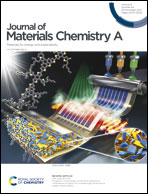Mitigating self-discharge and improving the performance of Mg–S battery in Mg[B(hfip)4]2 electrolyte with a protective interlayer†
Abstract
Magnesium–sulfur (Mg–S) battery is receiving much research attention because of its high theoretical energy density, low-cost and sustainable electrode materials. However, the major issues such as self-discharge, low sulfur utilization in cathode and magnesium anode passivation severely hamper the battery operation. In this study, spontaneous magnesium polysulfide formation is observed in the Mg[B(hfip)4]2, Mg(TFSI)2–MgCl2 electrolytes, which leads to severe self-discharge of Mg–S cells. Interestingly, unlike in lithium–sulfur battery, these magnesium polysulfides forms as crystalline magnesium polysulfide on the magnesium foil, which could escalate the self-discharge of the cells. The incorporation of graphene–polyaniline coated carbon cloth (GPN–PANI@CC) as a protective interlayer which effectively adsorbs the polysulfide and inhibit the self-discharge of Mg–S cells in the non-corrosive Mg[B(hfip)4]2 electrolyte. This interlayer not only improve the polysulfide retention in cathode but also the capacity values in Mg[B(hfip)4]2 electrolyte compared to Mg(TFSI)2–MgCl2 electrolyte. The cells with interlayer show the initial capacity of 1121 mA h g−1 and maintained a capacity of 500 mA h g−1 after 150 cycles with coulombic efficiency of >99%. This cell design strategy provides a promising approach for improving metal–sulfur batteries.
![Graphical abstract: Mitigating self-discharge and improving the performance of Mg–S battery in Mg[B(hfip)4]2 electrolyte with a protective interlayer](/en/Image/Get?imageInfo.ImageType=GA&imageInfo.ImageIdentifier.ManuscriptID=D1TA06114C&imageInfo.ImageIdentifier.Year=2021)


 Please wait while we load your content...
Please wait while we load your content...